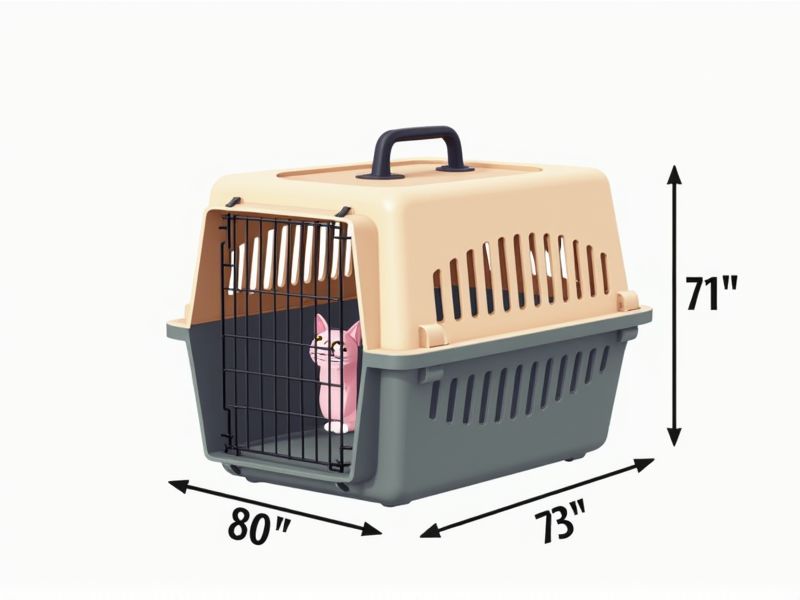
When selecting a cat carrier, it's important to consider standard dimensions to ensure your pet's comfort and safety. Most cat carriers typically range from 18 to 24 inches in length, 12 to 15 inches in width, and 10 to 13 inches in height. For example, a commonly recommended carrier size is about 19 inches long by 12 inches wide by 10 inches high, which fits most average-sized cats. Always ensure that your cat can stand, turn around, and lie down comfortably inside the carrier you choose.
Ventilation And Airflow
A cat carrier should include multiple ventilation openings, ensuring proper airflow to keep your pet comfortable during travel. Look for a design featuring mesh paneling or a series of strategically placed vents that promote ventilation while maintaining security. A minimum of two to four ventilation points is recommended to facilitate adequate air circulation and reduce heat buildup. Opting for carriers with adjustable ventilation options allows you to customize airflow based on the conditions and your cat's needs.
Material Durability
A high-quality cat carrier typically features materials such as reinforced nylon or heavy-duty polyester, ensuring exceptional durability and resistance to wear and tear. The carrier's frame often incorporates resilient plastic or metal structures, capable of withstanding significant impacts, which is crucial for safe transport. Look for additional features like scratch-resistant interiors and weatherproof exteriors, as these elements enhance longevity and protect against the elements. Choosing a carrier that meets these standards guarantees a safe and comfortable experience for your feline friend during travel.
Ease Of Cleaning
When selecting a cat carrier, prioritize models with removable, washable liners to simplify cleaning and maintain hygiene for your pet. Carriers constructed from materials like plastic or nylon can be wiped down easily, helping to eliminate odors and germs. Look for carriers with a smooth surface, as they offer less resistance to dirt and are easier to clean thoroughly. A well-designed carrier often includes ventilation openings that prevent the buildup of moisture, further enhancing your cat's comfort and your cleaning routine.
Storage Convenience
A high-quality cat carrier typically features collapsible designs that enhance storage convenience, allowing you to save up to 50% more space when not in use. Look for lightweight materials, weighing around 2-4 pounds, which simplify transport and make storage easy. Many carriers come with removable and washable liners, ensuring cleanliness and hygiene without cumbersome maintenance. When you choose a carrier with integrated storage compartments, you can conveniently keep treats, toys, and essential supplies organized and accessible during travel.
Weight Restrictions
When selecting a cat carrier, a crucial factor to consider is weight restrictions, which typically range from 15 to 25 pounds for most models. Ensuring that your carrier can comfortably accommodate your cat's weight not only enhances their safety but also complies with airline regulations if you plan to travel. A carrier with a sturdy design that supports this weight limit provides durability and ensures your pet's well-being during transit. Choosing a lightweight option can also ease handling, making it more convenient for you when transporting your feline companion.
Secure Locking Mechanism
A secure locking mechanism is crucial for ensuring the safety of your cat during travel in a carrier. Look for options that feature robust latches, typically made from durable materials, which can withstand feline attempts to escape. Some carriers even incorporate locking designs that prevent accidental openings, providing peace of mind for pet owners. When selecting a cat carrier, checking for these features will enhance your cat's security, supporting a more stress-free journey.
Handle And Strap Design
When selecting a cat carrier, the handle and strap design are crucial for both convenience and comfort. Look for carriers with ergonomic padded handles, which minimize hand fatigue, especially when carrying your pet for extended periods. A sturdy adjustable strap that can be worn crossbody provides additional versatility, allowing you to maintain balance while keeping your hands free. Many modern carriers feature dual handle options, enabling easy transport, whether you're navigating through a crowded airport or simply heading to the vet.
Airline Compliance
Airline-compliant cat carriers must adhere to specific dimensions, typically not exceeding 18 x 11 x 11 inches for soft-sided options and varying slightly for hard-sided versions. Most airlines require carriers with a secure latch, ventilation on multiple sides, and a waterproof base to ensure safety and comfort during travel. It's crucial to check with your chosen airline for their unique pet travel regulations, as some may mandate a maximum weight limit of 15-20 pounds including the pet and carrier. Investing in a high-quality carrier that meets these requirements ensures a smoother journey for both you and your feline friend.
Pet Comfort And Safety
When selecting a cat carrier, prioritize materials that ensure pet comfort, such as padded interiors and breathable fabrics. A standard cat carrier should have a sturdy frame to provide safety during travel, typically rated to hold up to 15 pounds for medium-sized cats. Look for carriers with secure locking mechanisms and side openings, allowing for easy access and minimal stress for your feline friend. Incorporating features like ventilation panels and a removable, washable bottom will enhance both hygiene and comfort during your journeys.
Size And Space Adaptability
When choosing a cat carrier, size is crucial, as carriers should ideally be at least 1.5 times the length of your cat from nose to tail. A spacious carrier, approximately 24 to 30 inches long, allows your cat to stand, turn around, and lie down comfortably. Consider a design that includes adjustable compartments to accommodate different breeds or multiple cats, enhancing space adaptability. Ensure the carrier is lightweight yet durable, usually weighing around 3 to 5 pounds, to facilitate ease of transport while providing safety and comfort for your feline friend.
